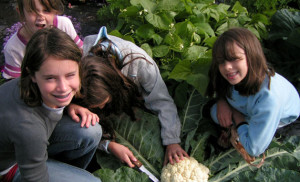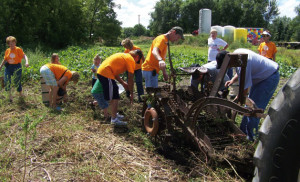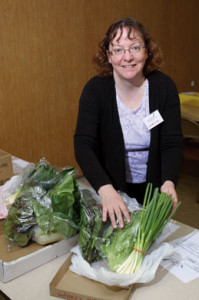Crisp, delicious greens delivered by the people who grow them — it’s one of the perks of being part of the Brookings-based South Dakota Local Foods Cooperative, says consumer member Elizabeth Fox. The customers place their orders online each month and then pick them up either in Brookings or Sioux Falls.

A portion of the community garden in Estelline is set aside for these youngsters, who learn about growing their own food.
“I find this very rewarding,†says Fox as she checks in the leeks, onions, arugula and other greens from Linda’s Gardens in Chester. Jacqui Kouf, who delivered the greens, says her employers are always looking for outlets for their fresh produce.
The help they seek is on the way
Through a one-year, $50,000 U.S. Department of Agriculture Rural Development Grant, Extension field specialists Kari O’Neill and Chris Zdorovtsov will launch a virtual center to provide these local producers with resources to help grow their businesses. Both Extension specialists work statewide, O’Neill through the Bennett County Extension office in the southwestern part of the state and Zdorovtsov in Sioux Falls.
Local producers are defined as those who sell agricultural goods anywhere except on the commodity market, O’Neill says. According to data from a South Dakota Department of Agriculture census, the state has at least 140 produce growers.
Testing strategies

Volunteers in Montrose, just west of Sioux Falls, work in the community garden. They all pitch in to do the work and then distribute their produce on Main Street, asking for a free will offering. Any leftovers are given to those in need.
As a part of the Local Food Collaborative Project, the researchers have enlisted the South Dakota Local Food Cooperative as a pilot group and will find ways to help the co-op expand its market.
The co-op now has 30 producer members who offer everything from grass-fed meat to soaps and home-baked bread to nearly 150 consumer members through its website, www.sdlocalfoodcoop.org, according to Holly Tilton Byrne, community organizer for Dakota Rural Action.
The Extension team will help the co-op investigate delivery route options to bring their products to more locations in eastern South Dakota.The co-op already has plans to expand its operations to Spearfish and Rapid City this summer.
Reaching out to producers
Program assistant Lindsey Kennedy, who works at the Sioux Falls Regional Extension Center, recently completed a survey to identify South Dakota lo

South Dakota Local Foods Cooperative member Elizabeth Fox sorts greens that will be distributed the next day to those who have ordered them.
cal food producers’ specific educational needs — where there are gaps in current resources, what materials are difficult to locate or understand and what training opportunities are most desired.
Using the 58 responses she received, Kennedy has identified content for a new Web-based local foods center on the SDSU Extension iGrow.org site, which the team hopes to launch in July. “Survey participants confirmed the need for a comprehensive resource that makes state regulations less cumbersome and allows them to access information in one location,†Kennedy says.
The main navigation buttons will cover handling and processing products, regulations and certification, marketing and group gardens. The virtual center also acknowledges the grant partners — South Dakota Department of Agriculture, South Dakota Value-Added Agriculture Center, Dakota Rural Action, South Dakota Buy Fresh Buy Local and USDA Rural Development.
“Helping to further develop the local food markets in the state will not only provide opportunities for increased entrepreneurship in rural areas, but it also has potential to increase the total amount of dollars circulating locally, create secondary businesses and improve access to foods in communities,†Zdorovtsov says.
Armed with these resources, “producers can take an aggressive approach to aggregating and marketing foods together,†O’Neill says. The end result will be more markets for these agricultural products, greater opportunities for local producers, and easier access to healthy food for consumers.
Christie Delfanian






